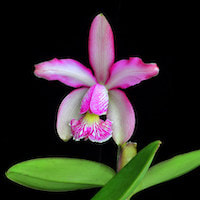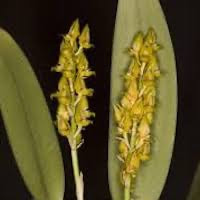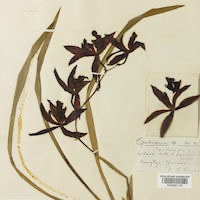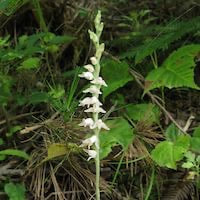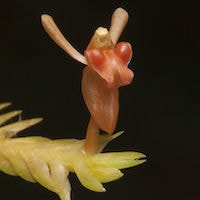Click for other Women's Floral 1, Floral 2, Floral 3, Floral 4, Floral 5, Floral 6, Floral 7, Floral 8, Floral 9, Floral 10, Floral 11, Floral 12
Contains Scented Notes of:
Iris - Check details at Scentopia's scent library
Native Singaporean Orchid notes: Cattleya (dolosa ‘Alba’ x schilleriana)
|
Cattleya (dolosa ‘Alba’ x schilleriana)- Used in Floral 12 (Women) for Team building Perfume workshop
Primary hybrid of a beautifully scented Cattleya. The dolosa parent has large, white fragrant flowers with pale yellow in the lip whereas the schilleriana has rich mahogany petals and sepals and a deep pink lip. The cross has a perfect balance of beauty and fragrance. |
Therapeutic Orchid notes:
|
Cymbidium wilsonii (Rolfe ex De Cock) Rolfe
Chinese names: Duanyechutou Lan (short leaf tiger head orchid), Diannanhutou Lan The lip becomes purplish-red after pollination. Flowering season is February to April. Herbal Usage: Herb is collected from Yunnan. Roots used to treat weak lungs, coughs, bronchitis, tonsillitis and body ache. Cymbidiums have been cultivated as house plants in the Far East for more than 2000 years. Ten aromatic glycosides were isolated from fresh flowers of the hybrid Cymbidium Great Flower ‘Marie Laurencin’, and two of these were new discoveries, namely marylaurensinosides D and E . An interesting group of compounds in Cymbidium are the lectins, a new class of antivirals which bind to N-linked oligosaccharide elements of enveloped viruses. Test tube experiments showed that mannose-specific lectins from a Cymbidium hybrid and Epipactis helleborine prevent human immunodeficiency (AIDS) viruses (HIV-1 and HIV-2) and cytomegalovirus (CMV) from reproducing themselves. |
|
Goodyera schlectendaliana Rchb. f.
Chinese names: Dabanye Lan (Large speckled orchid); Jinbian Lian (Gold border lotus); Yinherhuan (Silver ear orchid); Yinzong Lian (Silver palm lotus); Mountain jewel orchid Taiwanese names: Da Wu Shan Ban Ye Lan (Mountain dawn etched/speckled orchid), Gao Shan Lian (Mountain lotus) Japanese name: Miyama uzura (Quail of the deep mountain) This dwarf species is native to China, Japan and Southeast Asia. Phytochemistry: It contains a unique, complex flavonol glucoside that was given the name Goodyerin. It is 8-(4-hydroxy-3,5-dimethoxy- phenylmethyl) quercetin-3-O-rutinoside and has sedative and anti-convulsant activities. Usage: In TCM, the entire plant is used to clear the lungs, stop coughs, reduce swelling and pain, treat tuberculosis, coughs, phlegm, asthma and weak kidneys. A poultice of the leaves is applied for pain relief. Tincture is consumed with rice as a tonic for internal injuries. |
|
Liparis dunnii Rolfe
Chinese names: Dachunyangersuan (big lip sheep ear garlic), Fujianyangersuan (Fujian Province goat ear garlic) Chinese medicinal name: Shuangyejinqiang This narrowly-endemic species was originally discovered during a botanical expedition in cenral Fujian province in 1903 growing on rocks at Tze Chuk Hang |
|
Vanda cristata Wall ex Lindl. Syn. Trudelia cristata (Wall ex Lindl.) Senghas
Chinese name: Chachunwandai Lan Nepali name: Bhyagute phul in Nepali dialect, Vashgute phul Myanmar name: Jyo koke thitkhwa This is a common, epiphytic, vandaceous orchid, distributed in Nepal, Bhutan, northern India, Tibet and southwest Yunnan. In Bhutan and northeast India, it commonly occurs on the trunks of Rhododendron arboretum and Skimmia spp. Phytochemistry: The 1-hydroxymethylpyrrolizidine ester, laburnine acetate was isolated. Laburnine is a poisonous alkaloid originally isolated from unripe seeds of Laburnum anagyroides. It possesses antimicrobial activity against fungi and Shigella. Herbal Usage: Plant is made into a paste to treat cuts and wounds in India. In Nepal, a paste made with the roots is used for treating boils and dislocated bones. Leaf powder is used as an expectorant, whereas leaf paste is applied on cuts and wound. Leaves are also used to make a tonic and expectorant in NW India. It is used as a nutrient and tonic for general debility in Uttar Pradesh. |
Other scent notes
English Ivy, Freesia, Geranium, Pansy, Rose Petals, Safflower, Violet, Jasmin
